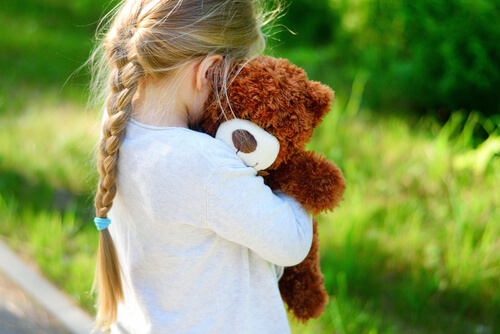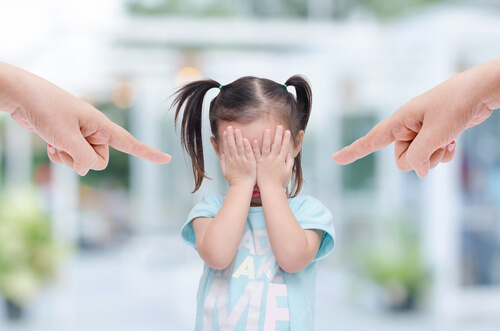The different forms of child abuse

The different forms of child abuse seem almost imperceptible sometimes. They have even been accepted as a natural part of a little one’s education on occasions. Some have seen it as necessary and have found it impossible to use other methods that weren’t based around violence.
However, nothing could be further from reality. Fortunately we already have studies to show that behind certain phrases there isn’t only a lie, but also a tragedy. We’re talking here about phrases such as “it’s always been done like that so don’t worry about it”, “spare the rod and spoil the child” or “he has to learn by hook or by crook”.
The problem of child abuse
The famous writer Agatha Christie was quite right when she said that “one of the most fortunate things that can happen to you in life is to have a happy childhood“. Undoubtedly, positive parenting is showing much more encouraging results in children’s education and development.
Elisabet Rodríguez is a child and adolescent and adult psychologist and specialist who has been deeply involved in the consequences of child abuse. She believes that in recent years it has experienced a considerable rise.

How can this be? Parents and educators are now more aware than ever of the repercussions of certain traditional forms of “instruction” which society has happily accepted in the past. How can it still be so ingrained?
The reason is that it has been shown that child abuse is not only physical. Despite being employed for years, psychological abuse is much less recognized than physical abuse in our society. That is why it is evolving at such a rapid rate.
Forms of child abuse
We understand the concept of child abuse to be an action taken by an adult towards a minor, which, either directly or indirectly, puts the emotional, mental or physical integrity of the child at risk. Under this definition, we can highlight 3 very clear forms of child abuse. All of them, to a greater or lesser extent, continue to take place today in many areas of our modern societies.
Physical abuse
This has been the most common form of abuse since time began. It is defined by specialists as a voluntary action that causes actual physical damage to the child, or the development of physical diseases.
Included in this type of child abuse, which seeks to intentionally inflict harm on the child, are different actions which vary according to their purpose. This can be an explicit rejection of the child, imposition of discipline, a sadistic and aggressive character, or the consequences of losing control.
Emotional abuse
Emotional abuse is the second type of child abuse that we want to highlight. In this type of abuse it is harder to identify the limits, and there are differing opinions regarding these limits. Even so, most experts consider it as behavior and actions taken towards a child based on verbal hostility through insults, threats and contempt.
“I cannot think of any childhood need as strong as protection from their father”
-Sigmund Freud-
This type of abuse rejects any attempt by the child to interact. It gives rise to emotional abandonment and passive attitudes in the parent when faced with the needs of their child, both directly and indirectly.

Child neglect
Finally, we have a third form of child abuse, known as child neglect. We are talking about a total or partial abandonment of the child’s care. The parent doesn’t attend to the child’s needs and keeps their distance from them. This isn’t always noticeable and can include a deliberate withholding of help towards the child.
According to different authors, negligence can be physical, but also social and emotional. This is different from physical abandonment. Negligence can be a conscious or unconscious act, and can take place through ignorance, or through an absence of positive values. A neglectful person may or may not know that these actions will cause psychological harm to the child.
We have seen that child abuse can take many forms. It is not always easy to detect them or to detect them in time. There are so many causes of child abuse and a lot are not immediately visible. However, the task of combating it is not insurmountable with sufficient attention and training.
“The best way to make children happy is to make them happy”
-Oscar Wilde-
The various forms of child abuse can and should be combated. How? Through education, training, empathy, positive values … It is a problem that we can help to alleviate if we all do our bit. Surely our children deserve our support…
The different forms of child abuse seem almost imperceptible sometimes. They have even been accepted as a natural part of a little one’s education on occasions. Some have seen it as necessary and have found it impossible to use other methods that weren’t based around violence.
However, nothing could be further from reality. Fortunately we already have studies to show that behind certain phrases there isn’t only a lie, but also a tragedy. We’re talking here about phrases such as “it’s always been done like that so don’t worry about it”, “spare the rod and spoil the child” or “he has to learn by hook or by crook”.
The problem of child abuse
The famous writer Agatha Christie was quite right when she said that “one of the most fortunate things that can happen to you in life is to have a happy childhood“. Undoubtedly, positive parenting is showing much more encouraging results in children’s education and development.
Elisabet Rodríguez is a child and adolescent and adult psychologist and specialist who has been deeply involved in the consequences of child abuse. She believes that in recent years it has experienced a considerable rise.

How can this be? Parents and educators are now more aware than ever of the repercussions of certain traditional forms of “instruction” which society has happily accepted in the past. How can it still be so ingrained?
The reason is that it has been shown that child abuse is not only physical. Despite being employed for years, psychological abuse is much less recognized than physical abuse in our society. That is why it is evolving at such a rapid rate.
Forms of child abuse
We understand the concept of child abuse to be an action taken by an adult towards a minor, which, either directly or indirectly, puts the emotional, mental or physical integrity of the child at risk. Under this definition, we can highlight 3 very clear forms of child abuse. All of them, to a greater or lesser extent, continue to take place today in many areas of our modern societies.
Physical abuse
This has been the most common form of abuse since time began. It is defined by specialists as a voluntary action that causes actual physical damage to the child, or the development of physical diseases.
Included in this type of child abuse, which seeks to intentionally inflict harm on the child, are different actions which vary according to their purpose. This can be an explicit rejection of the child, imposition of discipline, a sadistic and aggressive character, or the consequences of losing control.
Emotional abuse
Emotional abuse is the second type of child abuse that we want to highlight. In this type of abuse it is harder to identify the limits, and there are differing opinions regarding these limits. Even so, most experts consider it as behavior and actions taken towards a child based on verbal hostility through insults, threats and contempt.
“I cannot think of any childhood need as strong as protection from their father”
-Sigmund Freud-
This type of abuse rejects any attempt by the child to interact. It gives rise to emotional abandonment and passive attitudes in the parent when faced with the needs of their child, both directly and indirectly.

Child neglect
Finally, we have a third form of child abuse, known as child neglect. We are talking about a total or partial abandonment of the child’s care. The parent doesn’t attend to the child’s needs and keeps their distance from them. This isn’t always noticeable and can include a deliberate withholding of help towards the child.
According to different authors, negligence can be physical, but also social and emotional. This is different from physical abandonment. Negligence can be a conscious or unconscious act, and can take place through ignorance, or through an absence of positive values. A neglectful person may or may not know that these actions will cause psychological harm to the child.
We have seen that child abuse can take many forms. It is not always easy to detect them or to detect them in time. There are so many causes of child abuse and a lot are not immediately visible. However, the task of combating it is not insurmountable with sufficient attention and training.
“The best way to make children happy is to make them happy”
-Oscar Wilde-
The various forms of child abuse can and should be combated. How? Through education, training, empathy, positive values … It is a problem that we can help to alleviate if we all do our bit. Surely our children deserve our support…
This text is provided for informational purposes only and does not replace consultation with a professional. If in doubt, consult your specialist.







